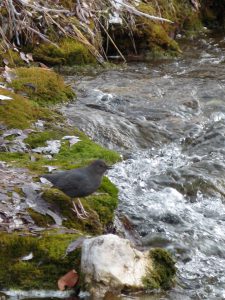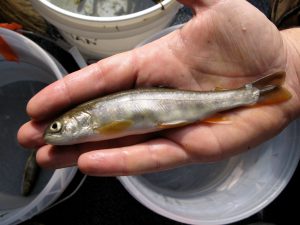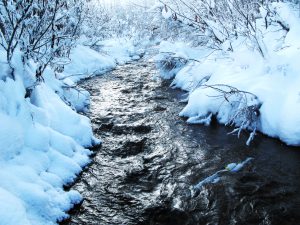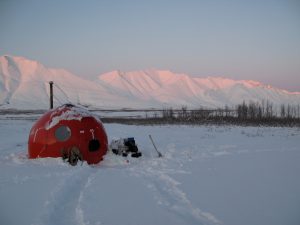American Dippers have more feathers per square inch than any other bird. That’s a good thing, too … particularly for those that call Alaska’s North Slope home, where temperatures can drop lower than -40 F for extended periods.

Like the dippers, Drs. Jon Benstead and Alex Huryn regularly endure the bitter winters of Alaska’s Arctic National Wildlife Refuge. And, since they’re not naturally equipped with a high feather per square inch insulation rating, these biologists rely on a combination of natural and man-made materials for warmth.
Benstead ticks off the layers. “Silk underwear, a layer of wool underwear, a layer of fleece, a layer of down, gloves, and then, as a final resort, very thick down pants and a huge thick parka. I’ve only worn that parka once, when it was minus 40. I have a pretty ridiculous hat, too.”
The pair of University of Alabama researchers deals with the frigid conditions in efforts to learn more about the relationships between the area’s free-flowing streams and the organisms that survive, even thrive, because of those streams.
About 99 percent of the streams that flow on the North Slope during the summer freeze during the winter. Many of them, in fact, freeze solid for seven to eight months each year. But, the remaining 1 percent has the researchers’ attention.
Benstead and Huryn focus on Ivishak Hot Spring, a tributary of the Ivishak River. This stream, as others, flows year-round because its source is an underground spring that lies beneath the permafrost – the layer of frozen soil that never thaws.

“Many species depend upon it because it’s the only place they can survive the winter,” Benstead says. It’s vital to fish like the Dolly Varden, a char which spawns in the spring-fed streams each year and whose young spend two years in the springs before moving downstream and into the ocean.
“These spring-fed streams are an unusual feature in this Arctic environment,” says Benstead, who, on this 92 degree July day in Tuscaloosa, faced no challenges keeping warm while on campus discussing the project with a visitor. “It’s the only place where there is shallow, liquid water. The only other liquid water you will find is below a meter and a half of ice in a lake, or a very deep river.
“We’re the first people,” Benstead says, “to do full-blown stream ecology in a spring stream up there in the winter.”

“Nobody knows the exact source of this water,” Huryn says. “It’s rainwater, and we know that it’s decades old.” Tests using radioactive tracers in nearby areas indicate the water entered the Earth during a period of atomic bomb testing, giving researchers a reliable estimate of the water’s age.
While some of these streams were known, Huryn and a colleague at the University of Alaska Fairbanks used thermal satellite imagery to locate others – more than 200 others – with spring-like features.
The three-year project is supported by a $550,000 National Science Foundation grant, along with a separate logistics budget. And it’s those logistics, the researchers say, that are the primary reason why such a project has previously gone un-tackled.
These College of Arts and Sciences’ researchers alternate spending three nights and four days at the site, which is 25 miles from the nearest road. They access it via helicopter from Toolik Field Station, an arctic research station 40 miles away. Along with UA graduate student James Ramsey and post-doctoral researcher Stephanie Parker, the scientists face a 36-hour trek, one-way, to get from the UA campus to Toolik. “It’s a pretty grueling trip,” Benstead says. And it’s one that either Huryn or Benstead make every month of the year, except December.
Despite the air temperature fluctuation throughout the year, the spring-fed streams remain at 5 or 6 degrees C. This water temperature stability along with stable flow rates enables the scientists to more accurately gauge some of the factors that most interest them. To understand an ecosystem, scientists study processes that use energy and nutrients to better understand their flow through the system. In this case, the unusual environment reduces some of the complexities involved in understanding the system.

“In most ecosystems, light and temperatures change together during the whole year, but, here, you have a situation where you have huge swings in light (including periods of 24 hour daylight and 24 hour darkness) and the energy it provides, but the temperature is a flat line,” Benstead says. “This decouples those two things. That’s important because it’s light that’s driving all the energy that goes into the system, and it’s temperature which drives a lot of the metabolic processes that are using up all the energy. Growth rates, decomposition, respiration – all those things aren’t affected by light, they are affected by temperature. As temperatures go up, they go up too. So, here, those things that use energy are sort of flat-lined throughout the year, but all the energy coming into the system is undergoing these huge swings.”
By using oxygen meters immersed in the stream and attached to data loggers, the UA scientists are able to regularly monitor oxygen concentrations, even between their trips to the site. “By measuring changes over time in oxygen concentrations, we can calculate how much primary production and respiration are occurring,” Benstead says. Organisms, like algae, are at the base of the food chain and are responsible for primary production.
Some tasks, like measuring uptake of nutrients, are complicated by the sub-freezing temperatures. Metered release of a nutrient solution into the spring (a common method of measuring plants’ nitrogen uptake rate, and, thereby growth) requires an uncommon approach when it’s minus 40. So, Huryn equipped a traditional water cooler, with a battery-heated pump that can disperse the solution into the stream.
By later taking water samples downstream, the researchers can measure the decline in the concentration of nitrogen and calculate the uptake rate. “That uptake rate is a nice metric of whole ecosystem biological activity that we can compare among seasons to see the effects of the changes in light on the activity of the whole system, and, in particular, the activity of the plants and microbes,” Benstead says. “It gives you an idea of the rate at which they are growing.”

Also by carefully measuring things such as the decay rate of leaf litter (by virtue of placing weighed leaves inside mesh bags into the stream and determining how quickly they break down), the scientists can determine the rate at which carbon is taken out of the ecosystem. “Microbes are doing a lot of this,” Benstead says, “although invertebrates are the other half of this equation.”
Moving up the area’s food chain, or food web, as the researchers call it, the scientists also closely monitor the Dolly Varden and those well-insulated American Dippers. They temporarily capture the Dolly Varden, anesthetize them, weigh and measure them, and then document their diets by slowly introducing a tube down their throats and flushing out their stomach contents. The researchers then tag and release the fish, so they can monitor their growth rates. And, in what’s a slightly more pleasant experience for the animals, but, not so much for the researchers, the scientists collect fecal matter of dippers and the river otters, which are present in the fall, to determine their diets.
Prior to the start of this project, post-doctoral researcher Parker had visited the site some 20 times, but never during the winter. Even though the data told her some of the springs would be flowing in -40 degrees, she almost couldn’t believe it until she stepped from the helicopter for the first time in January 2008 and witnessed it herself.
“Actually seeing it for the first time was really something,” Parker says.
While many organisms rely on the streams for their very existence during the frigid winters, they are not exactly enjoying a winter time “nirvana,” Huryn says. “They are hurting in the winter,” he says of the organisms. “The fish start losing weight.”
The entire system starts to wind down as it runs low of energy and the food chain appears to come close to breaking at its base. “The algae are a lot less abundant in the winter,” Parker says. “The numbers are way down. That’s what most insects are feeding on.”
But, thanks to those streams that just won’t freeze, life hangs on, and then the system bursts forth in renewal each spring. “This place just explodes in the summer with life,” Benstead says. “To get to see that change from winter to summer, when it’s just a jungle out there, we are very lucky.”
Almost as lucky, you might say, as the world’s best insulated birds on a minus 40 degree day.